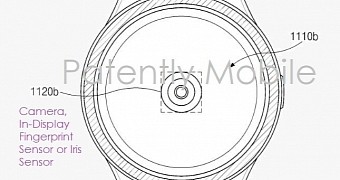Samsung is expected to bring a fingerprint sensor embedded into the screen on the Galaxy S10 in early 2019, but by the looks of things, the company may be planning to bring the same technology to more devices.
According to a recently-discovered patent, Samsung could be exploring ways to bring the fingerprint sensor into the screen on future smartwatches.
Basically, this would technically make it possible to unlock a smartwatch by simply putting your finger on the display, a feature that would work similarly to the one on phones.
According to the patent, Samsung wants to use a technology that it describes as force touch, and which means that users would have to press the screen harder in order to unlock the device. Interestingly, Samsung wants to use force touch only in a certain area of the screen and not across its entirety, so this means that the fingerprint scanning feature would also be limited to a specific part.
Galaxy S10 launching in early 2019
The South Korean firm has also provided more technical details regarding the screen that can be used in case this approach reaches mass production, explaining that capacitive, resistive, infrared, and ultrasonic sensors are all supported.
Samsung is expected to use an ultrasonic sensor on the Galaxy S10, though there are mixed reports in this regard at this point. While some sources claim that the fingerprint sensor would be embedded into the screen only on the top-of-the-range configurations, others suggest this feature would be offered across the entire lineup.
The Galaxy S10 is projected to go live in the first months of 2019. As for the smartwatch that may feature a fingerprint sensor integrated into the screen, it could be the next-generation Galaxy Watch, though it’s important to keep in mind that a patent is by no means living confirmation that this technology is ready for mass production.
Via PatentlyMobile

 14 DAY TRIAL //
14 DAY TRIAL //